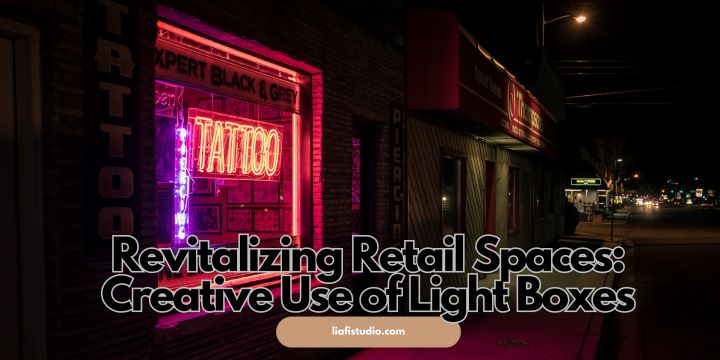Key Takeaways:
- Understanding how light boxes can transform retail environments.
- Exploring creative applications of light boxes in retail design.
- Examining the benefits of utilizing light boxes for enhanced customer experience.
Table of Contents:
- The Bright Impact of Light Boxes in Retail Displays
- Design Principles of Light Boxes for Attractive Window Displays
- Innovative Ways to Implement Light Boxes for Brand Identity
- Integrating Technology for Interactive Brand Experiences
- Customer Interaction and Light Boxes: A Dynamic Duo
- Cost-Effectiveness and Sustainability in Light Box Design
- Benefits Beyond the Dollar
- Installation Tips for Maximizing Appeal with Light Boxes
- Maintaining Visual Harmony
- Learning from Real-world Implementation
The Bright Impact of Light Boxes in Retail Displays
In the bustling retail environment where attention is currency, the visual appeal of a store can determine its success. The evolution of display technologies has brought forward the eye-catching allure of the light box display, a runaway favorite among marketers to attract and hold the consumer’s gaze. When strategically integrated within a retail space, these luminous frames can transform the mundane into something magnetic. They provide retailers with an edge, allowing them to showcase their products in the best light possible. The impact of a well-crafted light box display is immediate, drawing in potential customers with its beacon-like presence.
Design Principles of Light Boxes for Attractive Window Displays
Light boxes are a centerpiece around which narratives unfold when crafting window displays. The careful application of design principles ensures these displays not only blaze bright but communicate effectively. An attention-grabbing light box should complement the store’s aesthetic, color palette, and theme while maintaining a subtle equilibrium with the products it accentuates. The mastery lies in delighting the consumer without overwhelming their senses. For instance, the color temperatures used in the lighting can influence a shopper’s perception of the products, potentially affecting their purchase decision. Therefore, creating a captivating and product-focused display with light boxes requires a nuanced approach that melds artistry with strategic design.
Innovative Ways to Implement Light Boxes for Brand Identity
For brands, light boxes are more than just advertising tools; they are beacons of identity. Creative utilization of light boxes affords an innovative canvas where a brand’s story can unfold in vibrant colors and bold designs. Placing these message carriers in high-traffic areas or at key points within the store can repeatedly expose customers to the brand’s trademark visuals and slogans. This constant exposure helps etch the brand image in the consumer’s mind, enabling a more profound and longer-lasting connection. Incorporating consistent and reflective content within these luminescent frames can effectively translate the brand’s personality and ethos to the customer.
Integrating Technology for Interactive Brand Experiences
Retailers are increasingly melding digital engagement with traditional merchandising techniques. Interactive light boxes that incorporate digital screens offer dynamic content, and the addition of technologies like augmented reality or touch-responsive interfaces can craft an immersive brand experience. You can now see light boxes usher in a new way for displaying static images and engaging narratives that respond to and involve the customer, fostering a more profound brand-customer interactivity.
Customer Interaction and Light Boxes: A Dynamic Duo
Engaging customers is essential in converting them from casual onlookers to loyal patrons. Light boxes facilitate this by providing a platform for storytelling and product demonstration that captivates the viewer’s interest. Thoughtfully placed light boxes near new product ranges, for instance, can create an interactive hub where customers feel invited to engage with the products. Incorporating QR codes that lead to product information or promotional videos can also enhance the interactive nature of these fixtures and provide a robust platform for digital engagement within the physical store environment.
Cost-Effectiveness and Sustainability in Light Box Design
As businesses increasingly prioritize sustainability and profitability, the role of light boxes becomes even more pronounced. By adopting LED technology, retailers benefit from modern light boxes’ extended lifespan and energy efficiency, making them a practical choice in a cost-conscious and eco-aware market. The low heat output and customizable brightness levels also contribute to a more comfortable shopping experience while aligning with green business practices. The financial and environmental advantages render light boxes attractive for retailers seeking effective marketing solutions that do not compromise their corporate responsibility.
Benefits Beyond the Dollar
The economic and sustainable benefits of light boxes extend into operational efficiencies. With minimal maintenance demands and enduring high-quality illumination, LED-driven light boxes ensure consistent brand representation without the frequent need for servicing or replacement. They stand as a testament to their value proposition, satisfying both aesthetic and practical considerations for modern-day retailers.
Installation Tips for Maximizing Appeal with Light Boxes
Careful attention must be paid to their installation to maximize the appeal of light boxes. They should be strategically placed to support visual merchandising goals, drawing shoppers’ eyes to new and featured products or promotions. Adjusting the light intensity based on the time of day or the ambient light within the store ensures the light boxes stand out without being disruptive. Indeed, adjusting light intensity is crucial during evening hours or in dimmer areas of the shop to maintain visual harmony and attraction. Additionally, the content within these light boxes must stay current, changing with seasons, sales cycles, or promotional calendars to keep the customer interested and the brand’s messaging relevant.
Maintaining Visual Harmony
Amidst the vibrancy and uniqueness, light boxes must stay distinct from the store’s design language. They should feel like a seamless extension of the brand experience. Balancing light intensity with the store’s overall ambiance minimizes visual clutter, allowing the lightbox to stand out without conflicting with the surrounding elements. Thus, a synergy between the store’s design and the light box’s presentation should be maintained to provide shoppers with a coherent and visually pleasing shopping journey.
Learning from Real-world Implementation
Assimilating insights from the field can inform best practices for new adopters of this technology. Retailers strategically deploying light boxes with broader marketing initiatives tend to witness augmented benefits. The seamless integration of these displays into the overall narrative and atmosphere of the retail space cultivates a compelling experience that shoppers are drawn to, an experience that can turn a potential buyer into a repeat customer. Hence, the judicious application of light boxes, enriched by real-world examples, can shine a light on innovative pathways to retail revitalization.




